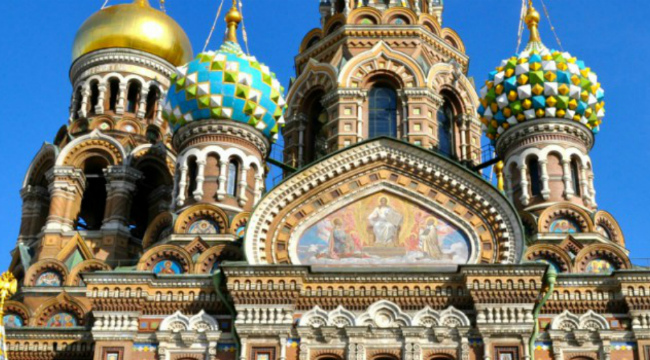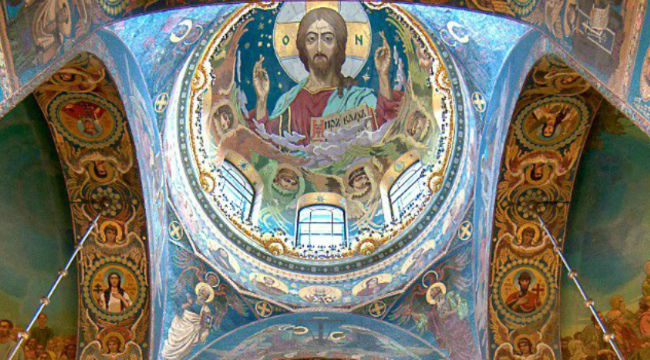The famous onion-shaped domes and colorful exterior of the unique looking church - the Church of the Savior on Spilled Blood - are what travelers to St. Petersburg often remember it by.
In fact, travelers who visited the capital of Russia probably instantly thought the picture represents the famous St. Basil's Cathedral in Moscow as both landmarks share many similarities. Another similarity of the sights is the number of names they are both referred to. The colorful landmark of St. Petersburg is also known as the Church of the Resurrection of Jesus Christ, Church on the Spilled Blood, Temple of the Savior on Spilled Blood, and the Cathedral of the Resurrection of Christ. Similarly, the St. Basil's Cathedral is also known as Cathedral of Vasily the Blessed, Cathedral of the Intercession of the Most Holy Theotokos on the Moat or Pakrovsky Cathedral.
1. History Behind
However, this post is about the Church of the Savior on Spilled Blood and three reasons why you should pay a visit to the top sight of St. Petersburg. One thing that draws travelers to the sight is its fascinating history. The Church was first built in 1883 to honor the memory of Alexander II, who was responsible for the emancipation of serfs in 1861 that put an end to Russian slavery - five years before the emancipation of slaves in the US.

On March 13, 1881, Tsar's carriage was passing the embankment of Griboedov Canal, where the Church of the Savior on Spilled Blood is situated now when a grenade was thrown by an anarchist exploded. The killing attempt had failed as unhurt tsar got out of his carriage and started to remonstrate with the protestor.
Although, a minute later a second conspirator threw another bomb killing himself and taking Alexander's II life with him. The site of the attack was marked with a temporary shrine whilst the plans for the more permanent memorial were undertaken.
The Church of the Savior on Spilled Blood Facts
- Location: Saint Petersburg, Russia
- Affiliation: Russian Orthodox
- Style: Russian Revival architecture
- Construction Start: 1883
- Completed: 1907
The construction works began in 1883 during the reign of the tsar's son Alexander III and were finished 24 years later, during the reign of Nicholas II. The estimated cost of the memorial construction is about 4.6 million rubles, way over the budgeted 3.6 million. The landmark was funded by Imperial family and many private donors. Unfortunately, during the Russian Revolution of 1917, the landmark was greatly damaged and closed by Soviets in the 1930s.
During World War II, the Church served as a storage facility for food and had suffered even more damages and after the war was over it was used again as a storage facility, this time for a local opera company. Once the St. Isaac's Cathedral took back the management of the landmark and began the reconstruction works, which lasted for 25 years. The Church as we know it now has opened its doors again in 1997 but does not function as a public place of worship.

2. Architectural Splendor
Another significant aspect of the Church, which is usually the main reason that sparks the desire for a visit, is its breathtaking architecture. The Church of the Savior on Spilled Blood differs from other buildings and religious structures in Saint Petersburg. Moreover, a majority of the buildings in the city are of baroque or neoclassical architectural styles, whereas the Church reflects the spirit of romantic nationalism. The Church was modeled after 16th and 17th century the Yaroslavl architectural style of churches (same as St. Basil's Cathedral in Moscow).
The designated architect of the famous religious structure was Alfred Alexandrovich Parland, who wasn't born in Russia. The non-Russian architect's roots could have been the reason why the landmark's architecture varies greatly from other buildings in the second capital.

3. The Great Mosaic Collection
The third reason why travelers should visit the astonishing landmark of Saint Petersburg is the inside of the Church. The interior will surely take your breath away with 23 130 square feet of the mosaic collection (including mosaics of the exterior) - one of the largest in Europe. The colorful mosaic is based on the paintings of Vasnetsov, Nesterov, and Vrubel. The inside of the main dome of the Church is decorated with the iconic mosaic painting of the Christ Pantokrator and is one of the most memorable art pieces from the Church. There are many more extraordinary examples of art displayed in the mosaic, which is best to see in person. Watch our rep Vera show you around the landmark and tell you more about it:
Did you know?
Some of the most recognized Russian artists, including Viktor Vasnetsov, Mikhail Nesterov, and Mikhail Vrubel, participated in creating the church's interior. No surprise that the church's construction went beyond budget: 3.6 million rubles at start of the construction and over 4.6 million at the end.
To summarize, the Church of the Savior on Spilled Blood is a unique sight of Saint Petersburg, that is rich in history and is also an incredible example of Yaroslavl church architectural style with beautiful domes and the mosaic collection. You could visit the famous site of the city during every tour to Russia that includes guided days in Saint Petersburg.
